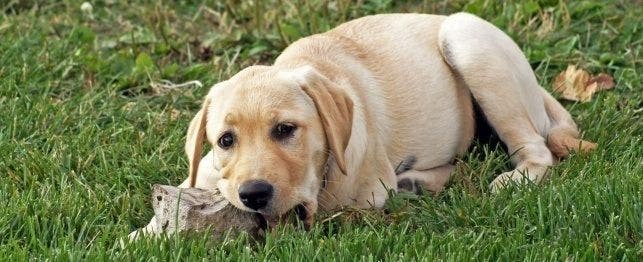
Why Do Dogs Eat Rocks?
Why Do Dogs Eat Rocks?
Dogs eat a lot of questionable things that, from our point of view, make no sense, such as their own or another animal’s stool. Although unpleasant to contemplate, it’s relatively normal behavior, especially for young dogs.
But dogs sometimes try to eat inorganic matter that has no digestive upside at all. Rocks provide an example of one of the more common non-food objects dogs chew on. This behavior is sometimes called pica, the term used to describe the craving and ingesting of nonfood items.
Chewing rocks can be dangerous to more than your dog’s teeth or soft mouth tissues. It can lead to intestinal blockage, vomiting, diarrhea, or even choking, if the rock is large enough to block your dog’s throat.
What causes this bizarre behavior? There are a number of possibilities that range from medical to behavioral. Chewing rocks may be one way for an attention-starved dog to get noticed. In this instance, the dog may even be acting out of boredom, anxiety or frustration.
There may also be medical reasons behind the behavior. Disorders of the intestinal tract, deficiency of some vital nutrient, such as iron, or diabetes mellitus (as well as other illnesses) may underlie indiscriminate eating behavior. It’s important to rule out a medical cause for pica by visiting your veterinarian. If the pica is subsequently deemed to be a purely behavioral problem, you and your vet can devise a strategy to overcome it.
Pica, by the way, is not limited to rocks. It includes any non-digestible item, such as rubber bands, carpet, string, wood, etc. Stopping this behavior is difficult, and usually cannot be done just by scolding. Scolding may even “reward” the behavior if it’s an attempt to gain attention. Furthermore, to scold your dog after the fact is useless; he or she won’t connect the “correction” with the behavior.
Finding and Treating the Cause of Canine Rock Eating
Pica may be nothing more than an outlet for chewing. One strategy is to keep a good number of chew toys on hand, and rotating them every several days. For instance, put three chew toys out for your dog to play with, and keep three hidden. After several days, bring out the three hidden toys and remove the other three, so they always appear to be “new.”
If you catch your dog eating rocks, you may want to startle him out of the behavior with a loud noise or spray gun – but try not to let him see you doing it, or he may associate your presence with the noise or water. Praise him when he leaves items alone.
Look at your own schedule: is your dog left alone most of the time? In that case, spending more time with your dog will probably help. Better yet, aerobic play may leave him too tired and happy to want to chew rocks. A final strategy involves dietary and feeding changes. Ad libitum feeding of a high fiber weight reducing diet provides your dogs with a constant option, rocks or kibble. Many choose kibble! It’s best to check with your vet before switching your dog to a different diet if problems are to be avoided.
Your veterinarian may prescribe a behavioral drug to help defeat the pica. He or she may also refer you to an animal behaviorist, if necessary. Always keep your dog leashed when walking to stop him from eating inappropriate or dangerous items. If your dog runs in your backyard, clear out rocks and other dangerous items or keep him with you under supervision. (In other words, don’t just tie your dog up to restrict his movement and then leave him.)
If you and your dog look forward to running free in an off-leash doggie park, you may have to curtail these outings until the pica disorder is under control. For more information, see the article on pica.